Yamaha MM8 User Manual

Owner’s Manual
EN

SPECIAL MESSAGE SECTION
This product utilizes batteries or an external power supply (adapter). DO NOT connect this product to any power supply or adapter other than one described in the manual, on the name plate, or specifically recommended by Yamaha.
This product should be used only with the components supplied or; a cart, rack, or stand that is recommended by Yamaha. If a cart, etc., is used, please observe all safety markings and instructions that accompany the accessory product.
SPECIFICATIONS SUBJECT TO CHANGE:
The information contained in this manual is believed to be correct at the time of printing. However, Yamaha reserves the right to change or modify any of the specifications without notice or obligation to update existing units.
This product, either alone or in combination with an amplifier and headphones or speaker/s, may be capable of producing sound levels that could cause permanent hearing loss. DO NOT operate for long periods of time at a high volume level or at a level that is uncomfortable. If you experience any hearing loss or ringing in the ears, you should consult an audiologist.
IMPORTANT: The louder the sound, the shorter the time period before damage occurs.
NOTICE:
Service charges incurred due to a lack of knowledge relating to how a function or effect works (when the unit is operating as designed) are not covered by the manufacturer’s warranty, and are therefore the owners responsibility. Please study this manual carefully and consult your dealer before requesting service.
This product may also use “household” type batteries. Some of these may be rechargeable. Make sure that the battery being charged is a rechargeable type and that the charger is intended for the battery being charged.
When installing batteries, do not mix batteries with new, or with batteries of a different type. Batteries MUST be installed correctly. Mismatches or incorrect installation may result in overheating and battery case rupture.
Warning:
Do not attempt to disassemble, or incinerate any battery. Keep all batteries away from children. Dispose of used batteries promptly and as regulated by the laws in your area. Note: Check with any retailer of household type batteries in your area for battery disposal information.
Disposal Notice:
Should this product become damaged beyond repair, or for some reason its useful life is considered to be at an end, please observe all local, state, and federal regulations that relate to the disposal of products that contain lead, batteries, plastics, etc. If your dealer is unable to assist you, please contact Yamaha directly.
NAME PLATE LOCATION:
The name plate is located on the bottom of the product.The model number, serial number, power requirements, etc., are located on this plate.You should record the model number, serial number, and the date of purchase in the spaces provided below and retain this manual as a permanent record of your purchase.
ENVIRONMENTAL ISSUES:
Yamaha strives to produce products that are both user safe and environmentally friendly. We sincerely believe that our products and the production methods used to produce them, meet these goals. In keeping with both the letter and the spirit of the law, we want you to be aware of the following:
Battery Notice:
Model
Serial No.
Purchase Date
This product MAY contain a small non-rechargeable battery which (if applicable) is soldered in place. The average life span of this type of battery is approximately five years. When replacement becomes necessary, contact a qualified service representative to perform the replacement.
PLEASE KEEP THIS MANUAL
92-BP (bottom)
2 MM6/MM8 Owner’s Manual

FCC INFORMATION (U.S.A.)
1. IMPORTANT NOTICE: DO NOT MODIFY THIS UNIT! |
not guarantee that interference will not occur in all installations. If |
|
This product, when installed as indicated in the instructions con- |
this product is found to be the source of interference, which can be |
|
tained in this manual, meets FCC requirements. Modifications not |
determined by turning the unit “OFF” and “ON”, please try to elimi- |
|
expressly approved by Yamaha may void your authority, granted by |
nate the problem by using one of the following measures: |
|
the FCC, to use the product. |
Relocate either this product or the device that is being affected by |
|
|
||
2. IMPORTANT: When connecting this product to accessories and/ |
the interference. |
|
or another product use only high quality shielded cables. Cable/s |
Utilize power outlets that are on different branch (circuit breaker or |
|
supplied with this product MUST be used. Follow all installation |
fuse) circuits or install AC line filter/s. |
|
instructions. Failure to follow instructions could void your FCC |
In the case of radio or TV interference, relocate/reorient the |
|
authorization to use this product in the USA. |
||
antenna. If the antenna lead-in is 300 ohm ribbon lead, change the |
||
|
||
3. NOTE: This product has been tested and found to comply with the |
lead-in to co-axial type cable. |
|
requirements listed in FCC Regulations, Part 15 for Class “B” digital |
If these corrective measures do not produce satisfactory results, |
|
devices. Compliance with these requirements provides a reason- |
please contact the local retailer authorized to distribute this type of |
|
able level of assurance that your use of this product in a residential |
product. If you can not locate the appropriate retailer, please contact |
|
environment will not result in harmful interference with other elec- |
Yamaha Corporation of America, Electronic Service Division, 6600 |
|
tronic devices. This equipment generates/uses radio frequencies |
Orangethorpe Ave, Buena Park, CA90620 |
|
and, if not installed and used according to the instructions found in |
The above statements apply ONLY to those products distributed by |
|
the users manual, may cause interference harmful to the operation |
||
Yamaha Corporation of America or its subsidiaries. |
||
of other electronic devices. Compliance with FCC regulations does |
||
|
||
|
|
|
* This applies only to products distributed by YAMAHA CORPORATION OF AMERICA. |
(class B) |
OBSERVERA!
Apparaten kopplas inte ur växelströmskällan (nätet) så länge som den ar ansluten till vägguttaget, även om själva apparaten har stängts av.
ADVARSEL: Netspæendingen til dette apparat er IKKE afbrudt, sålæenge netledningen siddr i en stikkontakt, som er t endt — også selvom der or slukket på apparatets afbryder.
VAROITUS: Laitteen toisiopiiriin kytketty käyttökytkin ei irroita koko laitetta verkosta.
(standby)
This product contains a high intensity lamp that contains a small amount of mercury. Disposal of this material may be regulated due to environmental considerations.
For disposal information in the United States, refer to the Electronic Industries Alliance web site: www.eiae.org
* This applies only to products distributed by |
(mercury) |
YAMAHA CORPORATION OF AMERICA. |
|
COMPLIANCE INFORMATION STATEMENT (DECLARATION OF CONFORMITY PROCEDURE)
Responsible Party : Yamaha Corporation of America
Address : 6600 Orangethorpe Ave., Buena Park, Calif.
90620
Telephone : 714-522-9011
Type of Equipment : Music Synthesizer
Model Name : MM6, MM8
This device complies with Part 15 of the FCC Rules. Operation is subject to the following two conditions:
1)this device may not cause harmful interference, and
2)this device must accept any interference received including interference that may cause undesired operation.
See user manual instructions if interference to radio reception is suspected.
* This applies only to products distributed by |
(FCC DoC) |
YAMAHA CORPORATION OF AMERICA. |
|
IMPORTANT NOTICE FOR THE UNITED KINGDOM
Connecting the Plug and Cord
IMPORTANT. The wires in this mains lead are coloured in accordance with the following code:
BLUE : NEUTRAL BROWN : LIVE
As the colours of the wires in the mains lead of this apparatus may not correspond with the coloured makings identifying the terminals in your plug proceed as follows:
The wire which is coloured BLUE must be connected to the terminal which is marked with the letter N or coloured BLACK.
The wire which is coloured BROWN must be connected to the terminal which is marked with the letter L or coloured RED.
Making sure that neither core is connected to the earth terminal of the three pin plug.
• This applies only to products distributed by Yamaha Music U.K. Ltd. |
(2 wires) |
MM6/MM8 Owner’s Manual 3
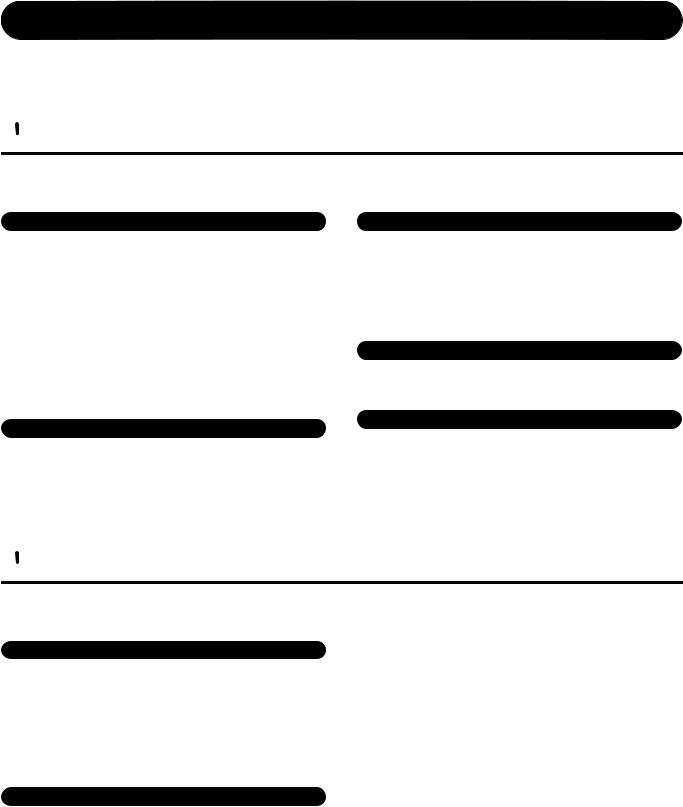
PRECAUTIONS
PLEASE READ CAREFULLY BEFORE PROCEEDING
* Please keep this manual in a safe place for future reference.
 WARNING
WARNING
Always follow the basic precautions listed below to avoid the possibility of serious injury or even death from electrical shock, short-circuiting, damages, fire or other hazards. These precautions include, but are not limited to, the following:
Power supply/AC power adaptor |
|
Water warning |
•Only use the voltage specified as correct for the instrument. The required voltage is printed on the name plate of the instrument.
•Use the specified adaptor (PA-5D, PA-150 or an equivalent recommended by Yamaha) only. Using the wrong adaptor can result in damage to the instrument or overheating.
•Check the electric plug periodically and remove any dirt or dust which may have accumulated on it.
•Do not place the AC adaptor cord near heat sources such as heaters or radiators, and do not excessively bend or otherwise damage the cord, place heavy objects on it, or place it in a position where anyone could walk on, trip over, or roll anything over it.
•Do not expose the instrument to rain, use it near water or in damp or wet conditions, or place containers on it containing liquids which might spill into any openings. If any liquid such as water seeps into the instrument, turn off the power immediately and unplug the power cord from the AC outlet. Then have the instrument inspected by qualified Yamaha service personnel.
•Never insert or remove an electric plug with wet hands.
Fire warning
•Do not put burning items, such as candles, on the unit. A burning item may fall over and cause a fire.
Do not open
•Do not open the instrument or attempt to disassemble the internal parts or modify them in any way. The instrument contains no user-serviceable parts. If it should appear to be malfunctioning, discontinue use immediately and have it inspected by qualified Yamaha service personnel.
If you notice any abnormality
•If the AC adaptor cord or plug becomes frayed or damaged, or if there is a sudden loss of sound during use of the instrument, or if any unusual smells or smoke should appear to be caused by it, immediately turn off the power switch, disconnect the adaptor plug from the outlet, and have the instrument inspected by qualified Yamaha service personnel.
 CAUTION
CAUTION
Always follow the basic precautions listed below to avoid the possibility of physical injury to you or others, or damage to the instrument or other property. These precautions include, but are not limited to, the following:
Power supply/AC power adaptor
•When removing the electric plug from the instrument or an outlet, always hold the plug itself and not the cord.
•Unplug the AC power adaptor when not using the instrument, or during electrical storms.
•Do not connect the instrument to an electrical outlet using a multiple-connector. Doing so can result in lower sound quality, or possibly cause overheating in the outlet.
Location
•Do not expose the instrument to excessive dust or vibrations, or extreme cold or heat (such as in direct sunlight, near a heater, or in a car during the day) to prevent the possibility of panel disfiguration or damage to the internal components.
•Do not use the instrument in the vicinity of a TV, radio, stereo equipment, mobile phone, or other electric devices. Otherwise, the instrument, TV, or radio may generate noise.
•Do not place the instrument in an unstable position where it might accidentally fall over.
•Before moving the instrument, remove all connected adaptor and other cables.
•When setting up the product, make sure that the AC outlet you are using is easily accessible. If some trouble or malfunction occurs, immediately turn off the power switch and disconnect the plug from the outlet. Even when the power switch is turned off, electricity is still flowing to the product at the minimum level. When you are not using the product for a long time, make sure to unplug the power cord from the wall AC outlet.
•Use only the stand specified for the instrument. When attaching the stand or rack, use the provided screws only. Failure to do so could cause damage to the internal components or result in the instrument falling over.
(3)-10 1/2
4 MM6/MM8 Owner’s Manual
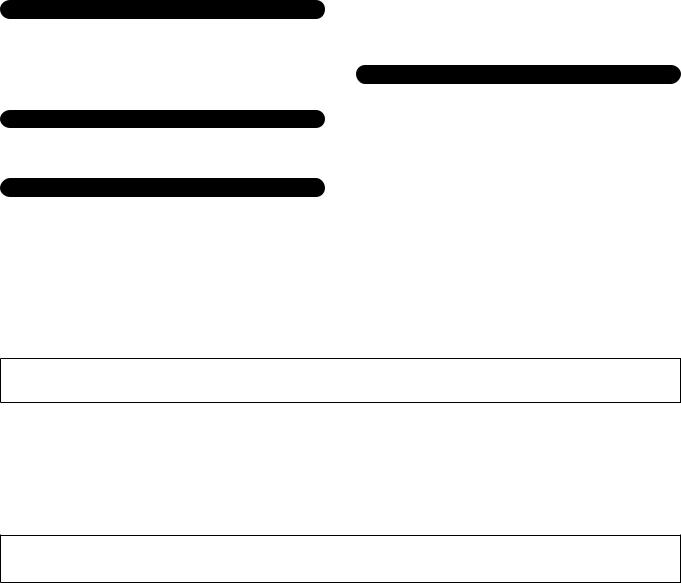
Connections
•Before connecting the instrument to other electronic components, turn off the power for all components. Before turning the power on or off for all components, set all volume levels to minimum. Also, be sure to set the volumes of all components at their minimum levels and gradually raise the volume controls while playing the instrument to set the desired listening level.
Maintenance
•When cleaning the instrument, use a soft, dry cloth. Do not use paint thinners, solvents, cleaning fluids, or chemical-impregnated wiping cloths.
•Do not use the instrument/device or headphones for a long period of time at a high or uncomfortable volume level, since this can cause permanent hearing loss. If you experience any hearing loss or ringing in the ears, consult a physician.
Saving data
Saving and backing up your data
•Saved data may be lost due to malfunction or incorrect operation.
Save important data to a USB storage device/or other external device such as a computer. (pages 69, 76)
Handling caution
•Never insert or drop paper, metallic, or other objects into the gaps on the panel or keyboard. If this happens, turn off the power immediately and unplug the power cord from the AC outlet. Then have the instrument inspected by qualified Yamaha service personnel.
•Do not place vinyl, plastic or rubber objects on the instrument, since this might discolor the panel or keyboard.
•Do not rest your weight on, or place heavy objects on the instrument, and do not use excessive force on the buttons, switches or connectors.
Backing up the USB storage device
•To protect against data loss through media damage, we recommend that you save your important data onto two USB storage devices or other external device such as a computer.
Yamaha cannot be held responsible for damage caused by improper use or modifications to the instrument, or data that is lost or destroyed.
Always turn the power off when the instrument is not in use.
Even when the power switch is in the “STANDBY” position, electricity is still flowing to the instrument at the minimum level. When you are not using the instrument for a long time, make sure you unplug the AC power adaptor from the wall AC outlet.
The illustrations and LCD screens as shown in this owner’s manual are for instructional purposes only, and may appear somewhat different from those on your instrument.
● Trademarks
•Windows is the registered trademarks of Microsoft® Corporation.
•Apple and Macintosh are trademarks of Apple Inc., registered in the U.S and other countries.
•The company names and product names in this Owner’s Manual are the trademarks or registered trademarks of their respective companies.
(3)-10 2/2
MM6/MM8 Owner’s Manual 5

This product incorporates and bundles computer programs and contents in which Yamaha owns copyrights or with respect to which it has license to use others’ copyrights. Such copyrighted materials include, without limitation, all computer software, style files, MIDI files, WAVE data, musical scores and sound recordings. Any unauthorized use of such programs and contents outside of personal use is not permitted under relevant laws. Any violation of copyright has legal consequences. DON’T MAKE, DISTRIBUTE OR USE ILLEGAL COPIES.
Copying of the commercially available musical data including but not limited to MIDI data and/or audio data is strictly prohibited except for your personal use.
6 MM6/MM8 Owner’s Manual

Congratulations, and thank you for your choosing the Yamaha MM6/ MM8 Music Synthesizer!
Please read this owner’s manual carefully before using the instrument in order to take full advantage of it’s various features.
When you have finished reading the manual keep it in a safe, accessible place, and refer to it when you need to better understand an operation or function.
Accessories
The instrument package includes the following items. Please check that you have them all.
•Owner’s Manual
•Supplied Disk (supplied DAW software)
•AC Power Adaptor (May not be included depending on the region in which you purchased the product. Please check with your Yamaha dealer.)
Since the MM6 and MM8 have the same control layout and input/output configuration, the MM6 will be used for example illustrations throughout this manual.
MM6/MM8 Owner’s Manual 7
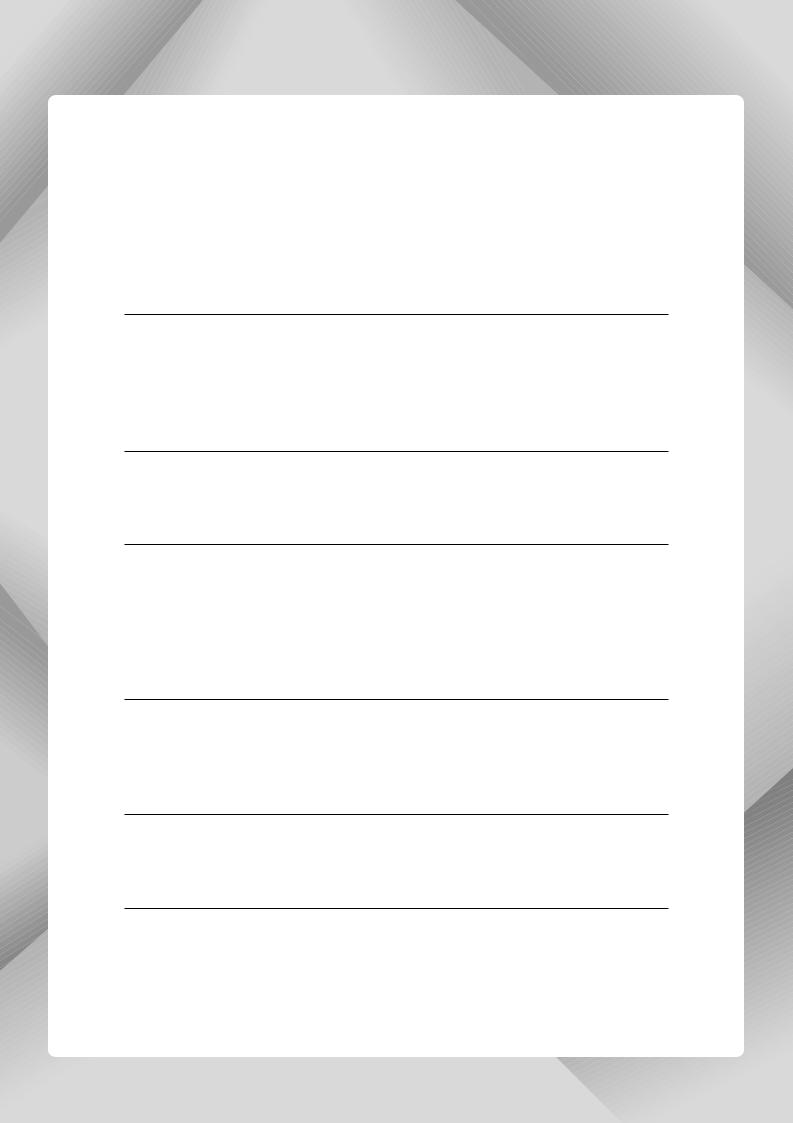
Main Features
■ High-Quality Voices for Keyboard Performance  Page 15
Page 15
The MM6/MM8 contains a wide range of high-quality voices (many based on the Motif Series voices), ranging from acoustic musical instruments to unique synthesizer sounds. Use the Category Search function to quickly call up the sounds you want, based on their instrument type. The MM8 features an 88-key “Graded Hammer” keyboard with action that is virtually indistinguishable from an actual acoustic piano.
■ Play the Keyboard Along with a Pattern  Page 23
Page 23
The patterns in the MM6/MM8 were created to give you a wide range of different musical genres simply by playing back the pattern tracks. Moreover, you can easily record chord changes to both the patterns and your real time keyboard performance in the Song mode.
■ Use the Arpeggio  Page 20
Page 20
The versatile Arpeggio feature automatically plays drum percussion phrases, guitar phrases, and analog synthesizer style phrases in response to the keys you play.
■Save and Switch Between Performance Settings (Performance Memory)  Page 59
Page 59
The Performance Memory lets you conveniently create and store combined settings for the voices you play (including keyboard splits and layers), the patterns you want to assign to backing tracks, and other important settings for live performance. These performance settings can be easily recalled by a single button press.
■ Controlling Filter and EG in Real Time  Page 41
Page 41
You can control the filter (cutoff and resonance) and EG (attack and release) in real time by using four knobs on the panel. Even these detailed sonic changes can be saved in the Performance Memory.
■ Save Performance Data to a USB Storage Device  Page 66
Page 66
Transferring data between the MM6/MM8 and your computer is easy because the MM6/MM8 can store data and setting to standard USB storage devices.
■Create Music with Your Computer and the Bundled DAW Soft-
ware  Page 80
Page 80
You can connect the MM6/MM8 to your computer using a USB cable, and transfer MIDI data to and from DAW software. With the Bundled DAW software the MM6/ MM8 becomes the central tone generator for your computer based music production system.
8 MM6/MM8 Owner’s Manual
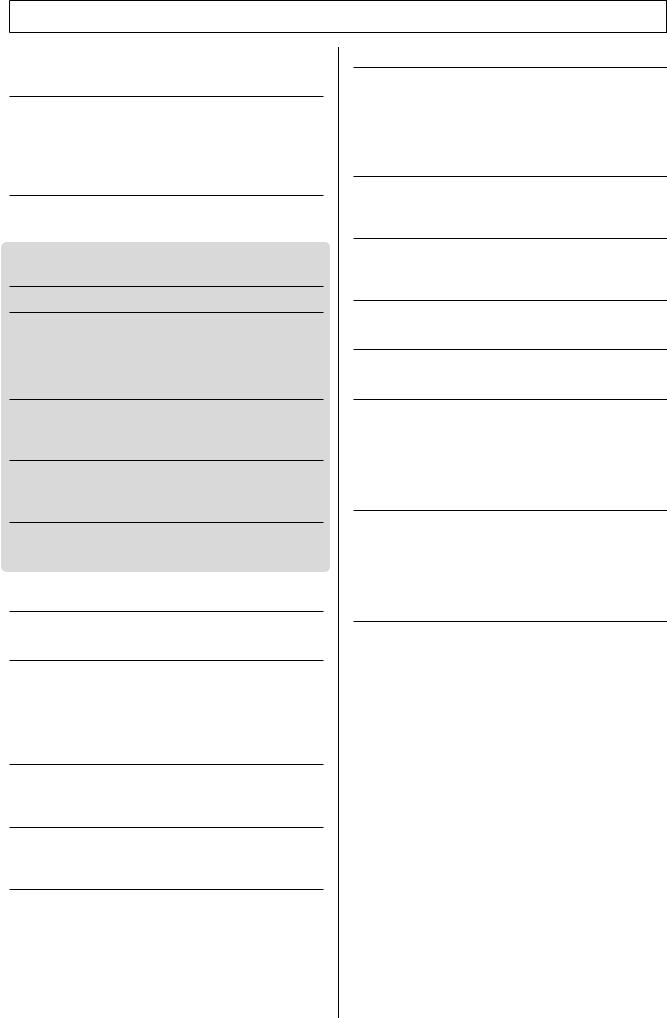
Contents
Accessories .............................................................................. |
7 |
Main Features .......................................................................... |
8 |
Setting Up |
10 |
Power Supply Connections .................................................... |
10 |
Cable clip................................................................................ |
10 |
Using Headphones................................................................. |
10 |
Connecting to a Computer (USB Terminal)............................ |
10 |
Turning the Power On ............................................................ |
11 |
Adjust Volume and Display Contrast ...................................... |
11 |
Panel Controls and Terminals |
12 |
Front Panel............................................................................. |
12 |
Rear Panel ............................................................................. |
13 |
Quick Guide |
|
Playing the Demo Song |
14 |
Play the Instrument |
15 |
Selecting the Main Voice........................................................ |
15 |
Combining Voices—Dual........................................................ |
16 |
Split the Keyboard .................................................................. |
17 |
Selecting a Drum Voice .......................................................... |
19 |
Using the Arpeggio Function .................................................. |
20 |
Playing Patterns |
22 |
Listen to the Rhythm Pattern.................................................. |
22 |
Play Along with a Pattern ....................................................... |
23 |
Playing Auto-accompaniment Chords .................................... |
25 |
Using Songs |
26 |
Selecting and Listening to a Song.......................................... |
26 |
Song Fast Forward, Fast Reverse, and Pause ...................... |
27 |
Types of Songs ...................................................................... |
28 |
Recording Your Own Performance |
29 |
Recording Procedure ............................................................. |
30 |
Song Clear—Deleting User Songs ......................................... |
33 |
Track Clear—Deleting a Specified Track from a User Song .. |
34 |
Backup and Initialization |
35 |
Backup ................................................................................... |
35 |
Initialization............................................................................. |
35 |
Basic Operation and Displays |
36 |
Basic Operation...................................................................... |
36 |
The Displays........................................................................... |
38 |
MAIN Display Items ................................................................ |
39 |
Reference |
|
Using the Controllers |
40 |
Controllers on the front panel ................................................. |
40 |
External Controllers ................................................................ |
41 |
Enhancing the Sound with Reverb, Chorus, and DSP |
|
Effects |
42 |
Selecting a Reverb type ......................................................... |
42 |
Selecting a Chorus type ......................................................... |
43 |
Applying DSP Effects ............................................................. |
44 |
Handy Performance Features |
45 |
Using the Metronome ............................................................. |
45 |
Adjusting the Tempo .............................................................. |
47 |
Using the TAP TEMPO Button ............................................... |
47 |
Setting the Touch Response .................................................. |
47 |
Select a Master EQ Setting for the Best Sound ..................... |
48 |
Controlling Arpeggio Volume with Keyboard Dynamics ......... |
48 |
Transpose the Keyboard ........................................................ |
49 |
Shifting Keyboard Pitch in Octaves ........................................ |
50 |
Pattern Functions |
51 |
Pattern Variations (Sections).................................................. |
51 |
Setting the Split Point ............................................................. |
52 |
Play a Pattern with Chords but No Rhythm |
|
(Stop Accompaniment) ...................................................... |
53 |
Pattern Volume Adjustment.................................................... |
53 |
Chord Basics .......................................................................... |
54 |
Specify Chords Over the Entire Keyboard Range .................. |
56 |
Song Settings |
57 |
Song Volume .......................................................................... |
57 |
Change the Song Tempo ....................................................... |
57 |
Track Mute.............................................................................. |
58 |
Memorize Your Favorite Panel Settings |
59 |
Saving to the Performance Memory ....................................... |
59 |
Recalling Settings from the Performance Memory ................. |
60 |
Erase a Performance Memory................................................ |
61 |
Voice Editing |
62 |
Select and Edit an Item .......................................................... |
62 |
Edit Display List ..................................................................... |
63 |
Utility Settings |
64 |
Selecting and Setting Functions ............................................. |
64 |
Utility Display List .................................................................. |
65 |
Storing/Saving Data |
66 |
Using a USB Storage Device ................................................. |
67 |
Formatting a USB storage device........................................... |
68 |
Saving Data ............................................................................ |
69 |
Convert a User Song to SMF Format and Save..................... |
70 |
Loading User Files and Pattern Files ..................................... |
71 |
Deleting Data from a USB Storage Device............................. |
72 |
Playing SMF Saved to a USB Storage Device ....................... |
72 |
Connections |
73 |
The Connectors ...................................................................... |
73 |
Connecting to External Audio Equipment............................... |
74 |
Connecting to External MIDI Devices..................................... |
74 |
Connecting a USB Storage Device ........................................ |
75 |
Connecting to a Personal Computer ...................................... |
77 |
Transferring Performance Data to and from a Computer ....... |
78 |
Initial Setup............................................................................. |
79 |
About the Supplied Disk |
80 |
About the Supplied DAW Software......................................... |
80 |
Support ................................................................................... |
80 |
Appendix |
|
Troubleshooting...................................................................... |
82 |
Messages ............................................................................... |
83 |
Voice List ................................................................................ |
84 |
Drum Kit List ........................................................................... |
90 |
Performance List .................................................................... |
96 |
Pattern List ............................................................................. |
98 |
Master EQ List........................................................................ |
99 |
Effect Type List..................................................................... |
100 |
Arpeggio Type List................................................................ |
104 |
MIDI Implementation Chart................................................... |
106 |
MIDI Data Format ................................................................. |
108 |
Specifications ....................................................................... |
109 |
Index..................................................................................... |
110 |
MM6/MM8 Owner’s Manual 9
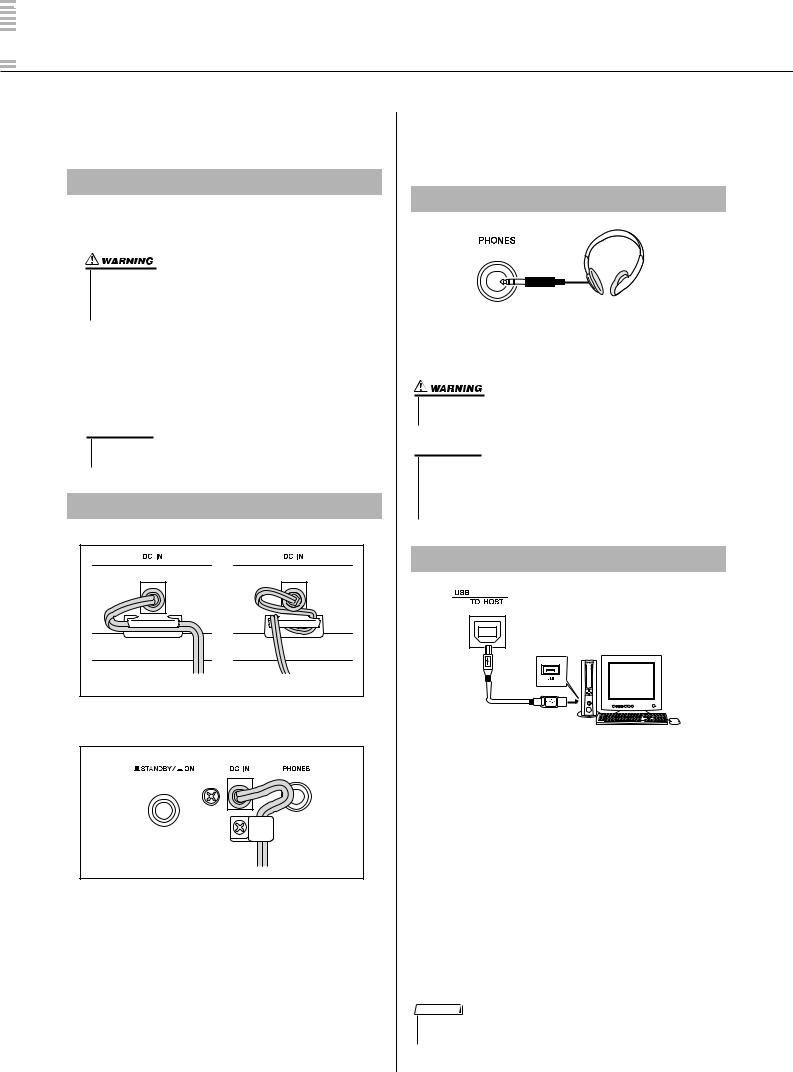
 Setting Up
Setting Up
Be sure to do the following BEFORE turning on the power.
Power Supply Connections
Make sure that the [STANDBY/ON] switch of the instrument is set to STANDBY.
•Use the specified adaptor (PA-5D, PA-150, or an equivalent recommended by Yamaha) only. The use of other adaptors may result in irreparable damage to both the adaptor and the instrument.
Plug the adaptor’s DC plug into the DC IN jack on the instrument’s rear panel.
Plug the AC adaptor into a convenient AC wall outlet.
 CAUTION
CAUTION
•Unplug the AC Power Adaptor when not using the instrument, or during electrical storms.
Cable clip
MM6 |
|
(PA-5D adaptor) |
(PA-150 adaptor) |
MM8 |
|
Wrap the DC output cable of the adaptor around the cable clip (as shown above) to prevent accidental unplugging of the cable during operation.
Avoid tightening the cord more than necessary or pulling on the cord strongly while it is wrapped around the cable clip to prevent wear on the cord or possible breakage of the clip.
Make all necessary connections, as described below, BEFORE turning the power on.
Using Headphones
Since the MM6/MM8 has no built-in speakers, it must be connected to an external amplifier and speakers, headphones, or other sound output device.
•Do not use headphones at a high volume for an extended period of time. Doing so may cause hearing loss.
 CAUTION
CAUTION
•When connecting the instrument to external equipment make sure that the power to all external devices is turned off to prevent possible electrical shock or equipment damage. Also be sure to turn any volume controls on external equipment to minimum when making connections to prevent possible speaker damage.
Connecting to a Computer (USB Terminal)
You can connect the instrument’s USB terminal to the USB terminal of a computer to allow transfer of performance data and song files between the two (page 77). To use the USB data-transfer features you’ll need to do the following:
•First, make sure the POWER switch on the MIDI device is set to OFF, then use a USB cable to connect the MIDI device to the computer.
•Install the USB-MIDI Driver on your computer.
You can download the proper USB-MIDI driver from our website:
http://www.global.yamaha.com/download/usb_midi/
Refer to the instructions included with the USB-MIDI Driver download package for the USB-MIDI Driver installation procedure.
NOTE
•USB cables can be purchased at some musical instrument stores, computer stores, and similar retail outlets.
10 MM6/MM8 Owner’s Manual
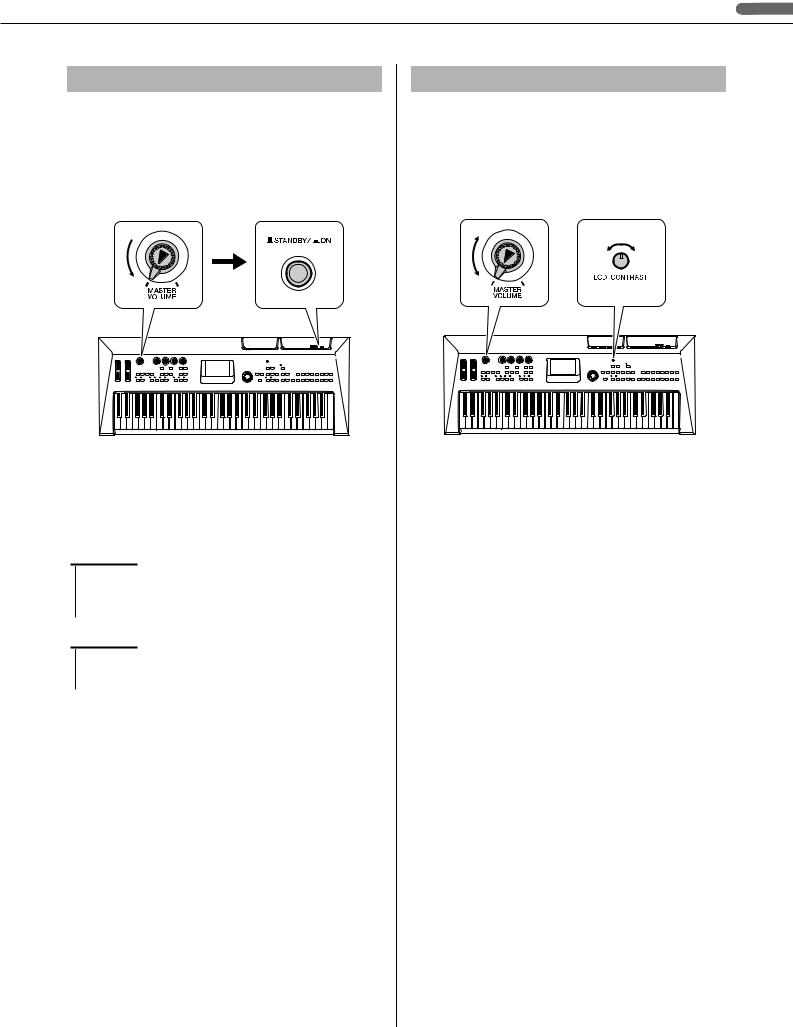
Setting Up
Turning the Power On
Turn down the volume by turning the [MASTER VOLUME] control to the left and press the [STANDBY/ON] switch to turn on the power. Press the [STANDBY/ON] switch again to turn the power OFF.
Rotate the [MASTER VOLUME] |
Press the [STANDBY/ON] |
control counter-clockwise. |
switch. |
Backup data is loaded from the internal flash memory when the power is turned on. If no backup data exists in the flash memory, all instrument settings are restored to the initial factory defaults.
 CAUTION
CAUTION
•Even when the switch is in the “STANDBY” position, a minute electrical current is present in the instrument. If you will not be using the instrument for an extended period of time, make sure you unplug the AC power adaptor from the wall AC outlet.
 CAUTION
CAUTION
•Never attempt to turn the power off when a “Writing..” message is showing on the display. Doing so can damage the flash memory and result in a loss of data.
Adjust Volume and Display Contrast
Set the MM6/MM8 and external playback equipment volume controls to appropriate levels. If necessary, adjust the legibility of the LCD display by using the LCD Contrast Control.
[MASTER VOLUME] |
Contrast Adjustment |
Control Adjustment |
MM6/MM8 Owner’s Manual 11

 Panel Controls and Terminals
Panel Controls and Terminals
Front Panel
|
e |
|
r |
!4 |
q |
w |
|
|
|
|
|
|
||
|
t y |
u |
o |
!0 |
|
i |
|
||
|
|
|
|
|
|
|
|
|
!1 |
|
|
|
!3 |
|
|
|
!2 |
|
|
Front Panel
q [PITCH BEND] wheel ........................... |
page 40 |
w [MODULATION] wheel......................... |
page 40 |
e [MASTER VOLUME] control....... |
pages 14, 36 |
r [CUTOFF], [RESONANCE], |
|
[ATTACK], [RELEASE] knobs............ |
page 41 |
t [METRONOME] button ........................ |
page 45 |
y [TAP TEMPO] button............................ |
page 47 |
u TEMPO [+], [-] buttons ........................ |
page 45 |
i SONG |
|
[SONG] button...................................... |
page 14 |
[PRESET], [USER], [USB] buttons ......page 26 |
|
o [PATTERN] button ................................ |
page 22 |
!0FUNCTION |
|
[EDIT], [UTILITY] buttons ............ |
pages 62, 64 |
!1FILE |
|
[MENU], [EXECUTE] buttons....... |
pages 67, 68 |
!2PATTERN CONTROL
[FINGER] button .................................. |
page 23 |
||||
[AUTO FILL IN] button......................... |
page 51 |
||||
[A]–[D] buttons .................................... |
page 51 |
||||
[SYNC START] button .................. |
pages 23, 51 |
||||
[START/STOP] button .................. |
pages 22, 37 |
||||
!3SONG CONTROL |
|
||||
[r] (REW) button .............................. |
page 27 |
||||
[f] (FF) button................................... |
page 27 |
||||
[REC] button ........................................ |
page 30 |
||||
[ |
|
|
|
] (PAUSE) button |
page 27 |
|
|
||||
[>/■] (START/STOP) button........ |
pages 27, 37 |
||||
!4Display .................................................. |
page 38 |
||||
!5Dial .......................................................... |
page 37 |
||||
!6[INC/YES], [DEC/NO] buttons ........... |
page 37 |
||||
!7[EXIT] button ........................................ |
page 38 |
||||
!8LCD CONTRAST knob ....................... |
page 11 |
||||
!9CATEGORY [INC], [DEC] buttons .... page 37
12 MM6/MM8 Owner’s Manual
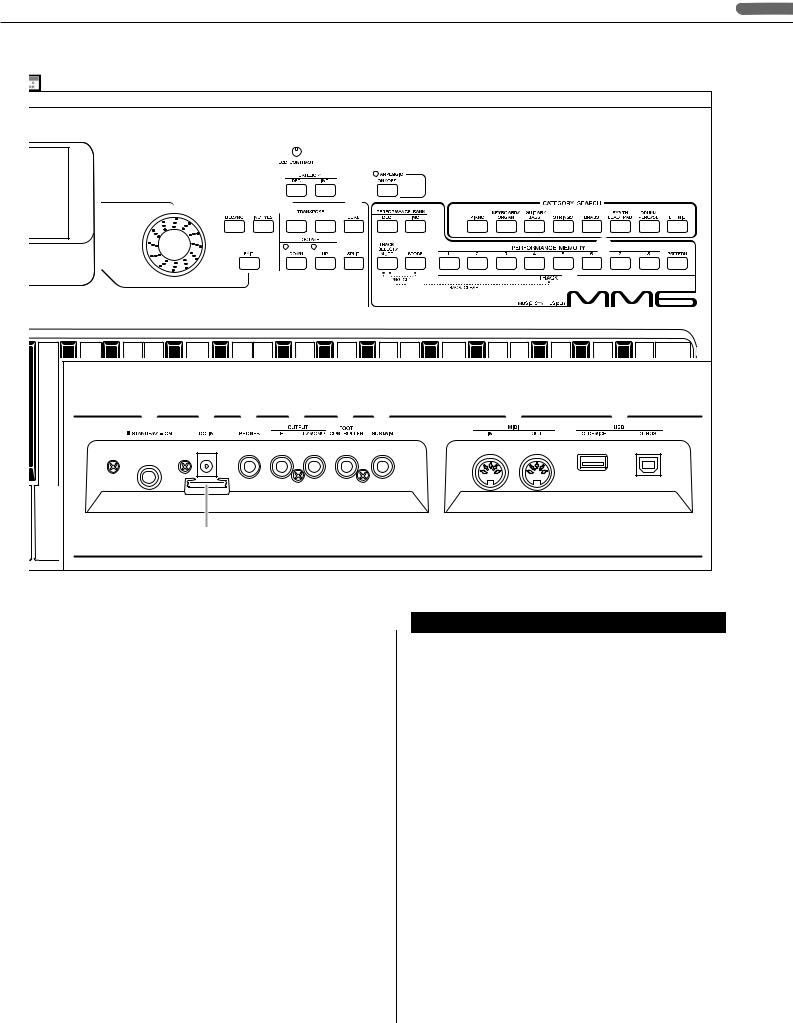
Panel Controls and Terminals
|
|
|
!8 |
|
|
|
|
|
|
|
@0 |
|
|
|
|
|
!9 |
|
|
#0 |
|
|
|
|
|
|
|
|
|
!6 |
@1 |
@3 |
|
|
|
|
|
|
@5 |
|
|
!5 |
|
|
|
|
|
@6 |
|
!7 |
|
|
|
|
|
|
|
|
@2 |
@4 @7 @8 |
|
@9 |
Rear Panel |
|
|
|
|
|
|
#1 |
#2 |
#3 |
#4 |
#5 #6 |
#7 |
#8 |
|
#9 |
|
|
|
|
|
@0[ARPEGGIO ON/OFF] button............. |
page 20 |
@1TRANSPOSE [+], [-] buttons.............. |
page 49 |
@2OCTAVE [UP], [DOWN] buttons ........ |
page 50 |
@3[DUAL] button ....................................... |
page 16 |
@4[SPLIT] button....................................... |
page 17 |
@5PERFORMANCE BANK [INC], |
|
[DEC] buttons ....................................... |
page 59 |
@6PERFORMANCE MEMORY |
|
[1]–[8] buttons....................................... |
page 59 |
@7[TRACK SELECT/MUTE] button ....... |
page 58 |
@8[STORE] button..................................... |
page 59 |
@9TRACK [1]–[8], |
|
[PATTERN] buttons .............................. |
page 29 |
#0CATEGORY SEARCH buttons........... |
page 15 |
Rear Panel
#1[STANDBY/ON] switch ....................... |
page 14 |
#2DC IN jack.............................................. |
page 10 |
#3PHONES jack........................................ |
page 10 |
#4OUTPUT R, L/MONO jacks ................ |
page 73 |
#5FOOT CONTROLLER jack ................. |
page 41 |
#6SUSTAIN jack ....................................... |
page 41 |
#7MIDI IN, OUT terminals....................... |
page 73 |
#8USB TO DEVICE, TO HOST |
|
terminals................................................ |
page 73 |
#9Cable clip............................................... |
page 10 |
MM6/MM8 Owner’s Manual 13
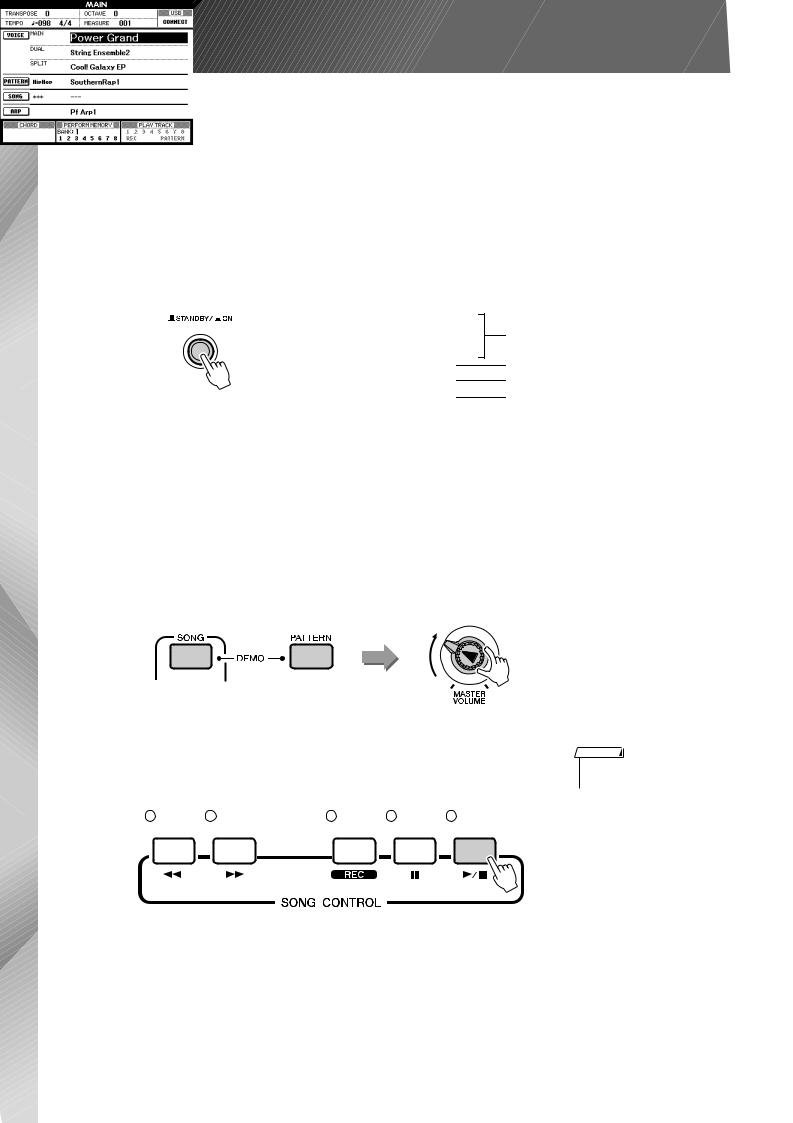
QuickGuide Playing the Demo Song
This instrument includes a Demonstration Song that demonstrate some of the instrument’s features and capabilities.
Let’s start by playing the Demonstration Song.
1 Press the [STANDBY/ON] button until it locks in the ON position.
The Main display will appear in the LCD.
VOICE name
PATTERN name
SONG name
ARPEGGIO name
2
3
Press the [SONG] button and [PATTERN] button simultaneously.
The Demo display appears in the LCD
Gradually raise the [MASTER VOLUME] control while listening to the instrument to set the desired listening level.
The Demo Song will play again from the beginning when the end is reached.
Press the [START/STOP] button to stop Demo playback.
The Main display will reappear.
NOTE
•The demo songs will not be transmitted via MIDI.
14 MM6/MM8 Owner’s Manual

QuickGuide Play the Instrument
In addition to piano, organ, and other “standard” keyboard instruments, this instrument has a large range of realistic voices—includ- ing guitar, bass, strings, sax, trumpet, drums and percussion, sound effects, and a wide variety of other musical sounds.
Selecting the Main Voice
Select a Main Voice and play it on the keyboard.
1 Press a CATEGORY SEARCH button.
The Main Voice selection display will appear.
The currently selected category name, voice number and name will be highlighted.
2 Select a voice you want to play from the current category.
Use the dial to select the desired voice. The available voices will be selected and displayed in sequence. The voice selected here becomes the Main voice.
For this example try selecting the “004 Early70’s”.
NOTE
•To change the Voice category, press another CATEGORY SEARCH button.
MAIN VOICE selection display
CATEGORY name
Current selected Voice
3 Play the keyboard.
Try selecting and playing a variety of Voices.
Press the [EXIT] button to return to the MAIN display.
MM6/MM8 Owner’s Manual 15

Play the Instrument
Combining Voices—Dual
You can select a second voice that will play in addition to the main voice when you play the keyboard. The second voice is known as the “Dual” voice.
Two voices will sound at the same time.
1
2
Press the [DUAL] button.
The currently selected dual voice will sound in addition to the main voice when you play the keyboard.
Press and hold the [DUAL] button for longer than a second.
The Dual Voice selection display will appear.
The currently selected category name, voice number and name will be highlighted.
|
Dual Voice selection display |
|
The currently selected category |
Hold for longer |
The currently selected Dual Voice |
than a second |
|
3 Select and press the desired category button in the CATEGORY SEARCH section.
NOTE
•To change the Voice category, press another category search button.
16 MM6/MM8 Owner’s Manual
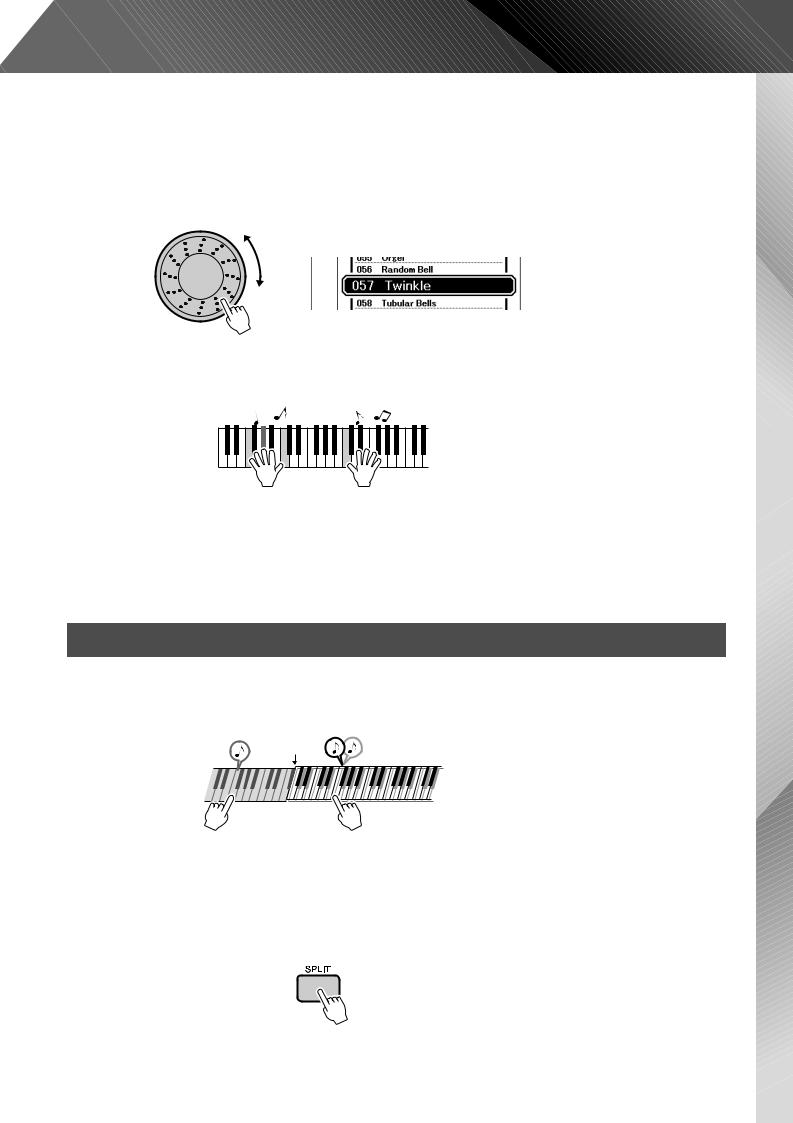
Play the Instrument
4
5
Select a voice you want to play.
Use the dial to select the desire voice. The available voices will be selected and displayed in sequence. The voice selected here becomes the Dual voice.
For this example try selecting the “057 Twinkle”.
Play the keyboard.
Try selecting and playing a range of Dual Voices.
Press the [EXIT] button to return to the MAIN display.
Split the Keyboard
In the split mode you can play different voices to the left and right of the keyboard “split point”. The main and dual voices can be played to the right of the split point, while the voice played to the left of the split point is known as the “split voice”. The split point setting can be changed as required (page 52).
Split point
Split Voice Main Voice and Dual Voice
1 Press the [SPLIT] button.
The currently selected split voice will sound to the left of the keyboard split point.
MM6/MM8 Owner’s Manual 17
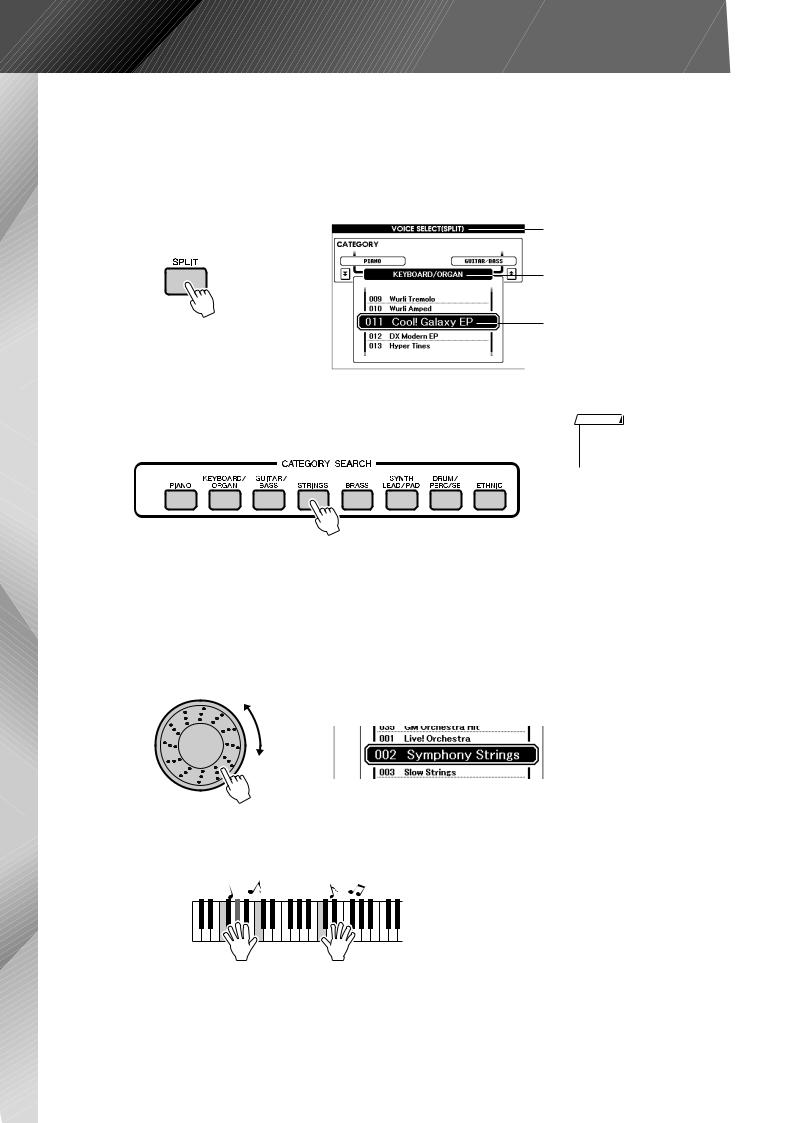
Play the Instrument
2 Press and hold the [SPLIT] button for longer than a second.
The Split Voice selection display will appear.
The currently selected category name, voice number and name will be highlighted.
Split Voice selection display
The currently selected category
The currently selected Split Voice
Hold for longer than a second
3
4
5
Select and press the desired category button in the CATEGORY SEARCH section.
Select a voice you want to play.
Use the dial to select the desired voice. The available voices will be selected and displayed in sequence. The voice selected here becomes the Split voice.
For this example try selecting the “002 Symphony Strings”.
Play the keyboard.
NOTE
•To change the voice category, press another CATEGORY SEARCH button.
Try playing the selected Split Voice.
Press the [EXIT] button to return to the MAIN display.
18 MM6/MM8 Owner’s Manual
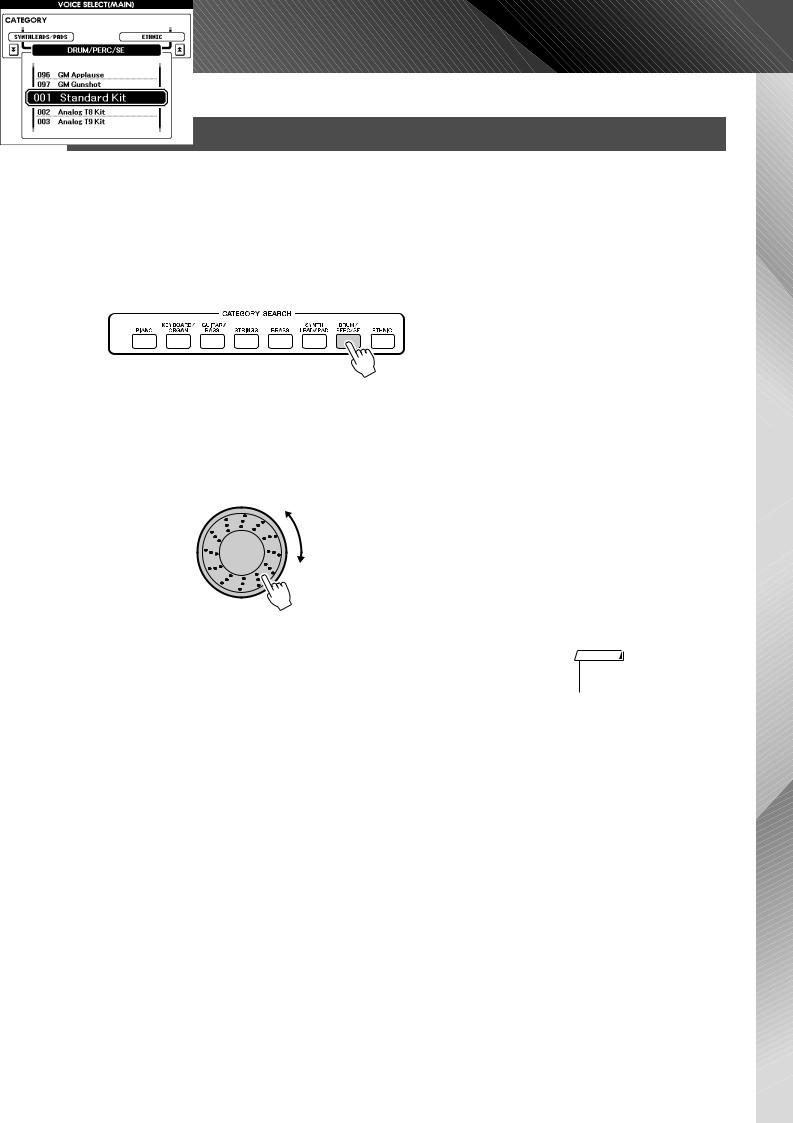
Play the Instrument
Selecting a Drum Voice
Drum Kits are collections of drum and percussion instruments.
1 Press the [DRUM/PERC/SE] button.
The DRUM Kit category will appear in the display.
2 Use the dial to select the Drum Kit you want to play (001– 023).
3 Play each key and enjoy the Drum Kit.
NOTE
•See the Drum Kit List on page 90.
MM6/MM8 Owner’s Manual 19
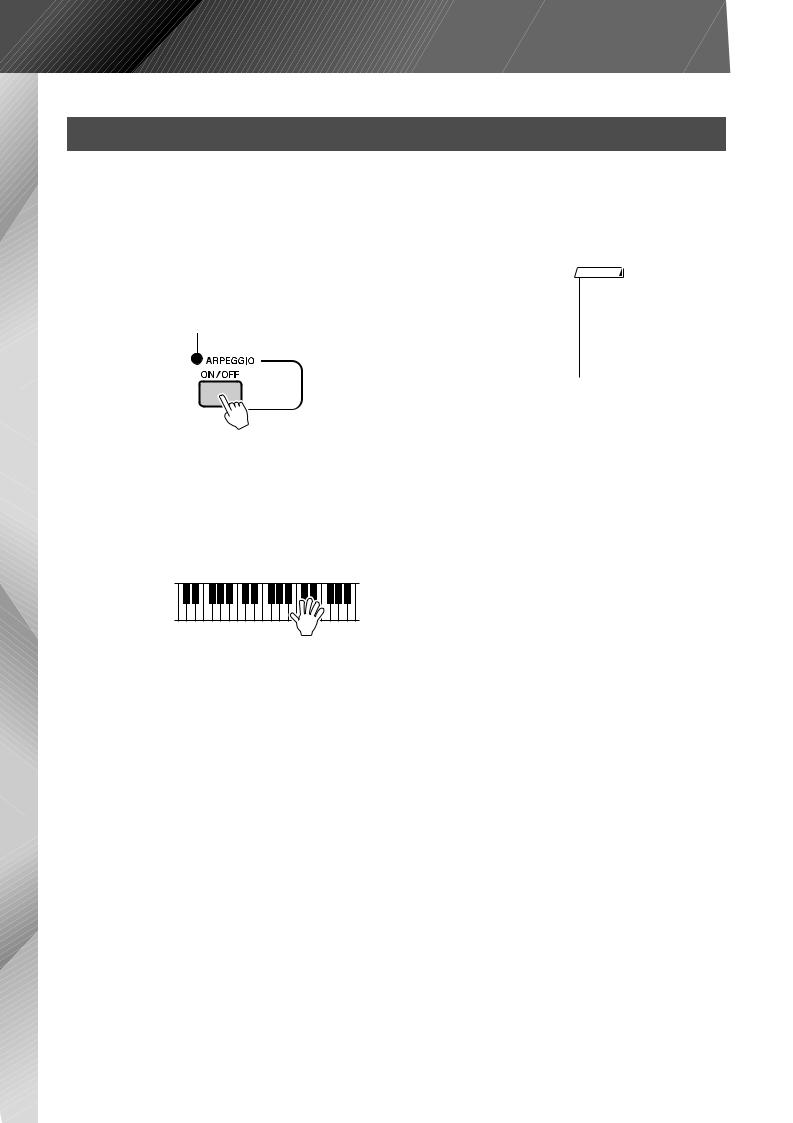
Play the Instrument
Using the Arpeggio Function
The arpeggio function lets you create arpeggios (broken chords) by simply playing the required notes on the keyboard. For example, you could play the notes of a triad—the root, third, and fifth—and the arpeggio function will automatically create a variety of interesting arpeggio-type phrases. By changing the arpeggio type and the notes you play it is possible to create a wide range of patterns and phrases that can be used for music production as well as performance.
1 Press the [ARPEGGIO ON/OFF] button to turn Arpeggio on.
The indicator lights when ARPEGGIO is ON.
2 Play a note or notes on the keyboard to trigger Arpeggio playback.
The rhythm pattern or phrase that plays depends on the actual notes or chords you play, as well as on the selected Arpeggio type.
NOTE
•The Arpeggio function can only be applied to the main and dual voices. When Keyboard Out is set to ON (page 78), arpeggios will be transmitted via MIDI channel 1. When Dual Voice is used arpeggios will be transmitted via MIDI channel 2.
3 When you have finished using with the arpeggio function, press the [ARPEGGIO ON/OFF] button to turn it off.
20 MM6/MM8 Owner’s Manual
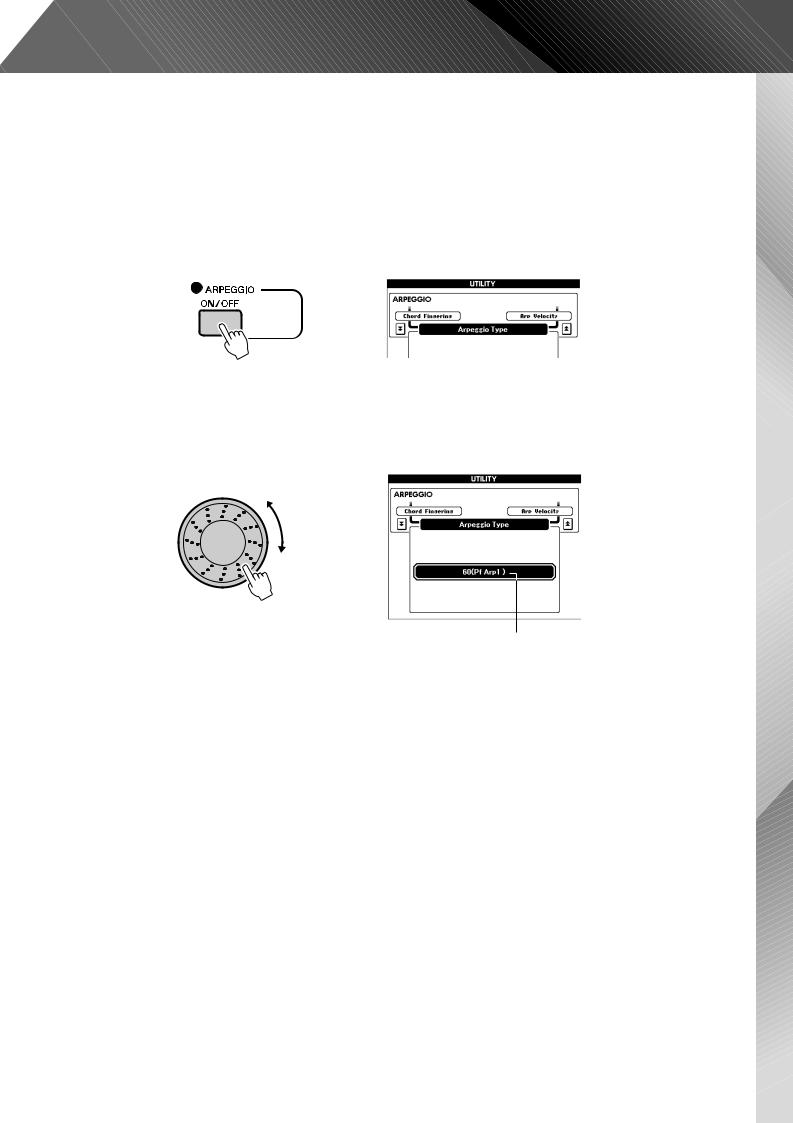
Play the Instrument
■Changing the Arpeggio type ● ● ● ● ● ● ● ● ● ● ● ● ● ● ● ● ● ● ●
The most suitable arpeggio type is automatically selected when you select a voice, but you can easily select any other arpeggio type.
1 Press and hold the [ARPEGGIO ON/OFF] button for longer than a second.
The arpeggio type selection display will appear.
Hold for longer than a second
2 Use the dial to select the desired arpeggio type.
A list of the available arpeggio types is provided on page 104.
Arpeggio type
The sound of the arpeggio produced will change according to the number of notes you play and the area of the keyboard you play in.
You can save the instrument’s settings at this point and then recall them at any time you want to repeat your performance (page 59).
You can also record your performance (page 29).
MM6/MM8 Owner’s Manual 21
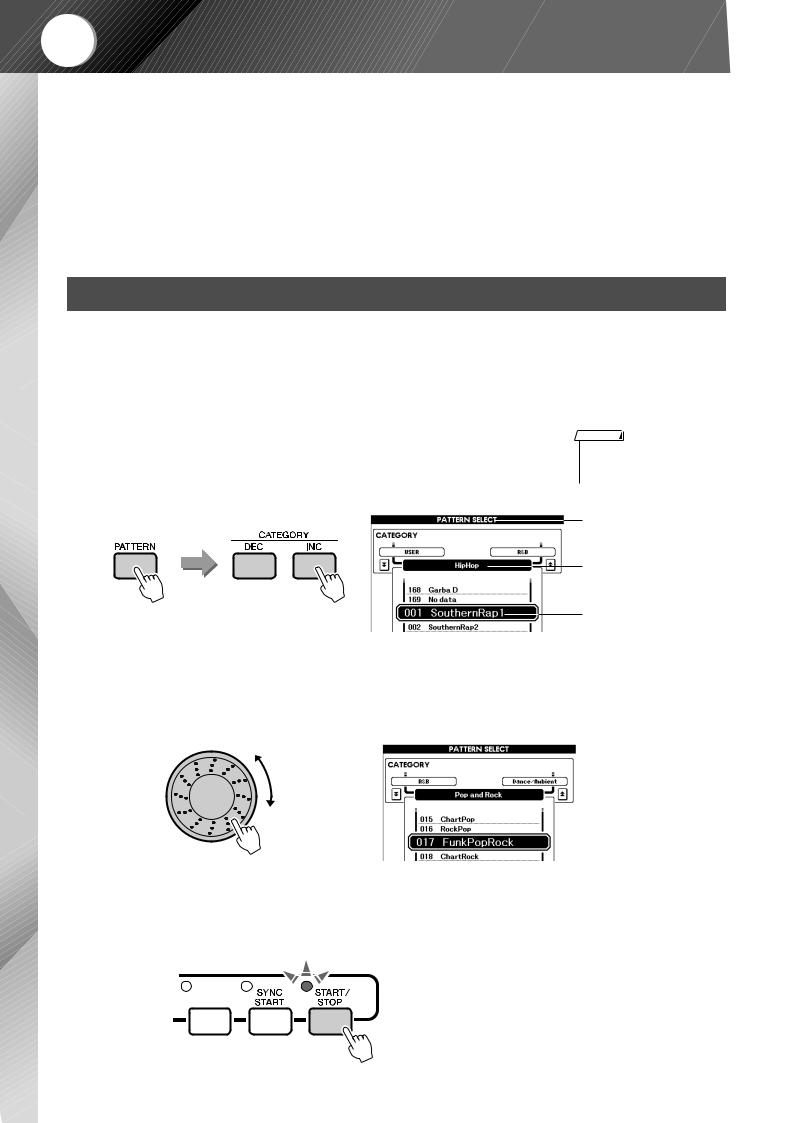
QuickGuide Playing Patterns
This instrument has an auto accompaniment feature that produces accompaniment (rhythm + bass + chords) in the pattern you choose to match chords you play with your left hand. A range of patterns with different time signatures and arrangements are provided (refer to the Pattern List on page 98).
In this section we’ll learn how to use the auto accompaniment features.
Listen to the Rhythm Pattern
Most patterns include a rhythm part. You can select from a wide variety of rhythmic types—R&B, HipHop, Dance, and many, many more.
Let’s begin by listening to just the basic rhythm. The rhythm part is played using percussion instruments only.
1
2
Press the [PATTERN] button.
The Pattern selection display will appear.
The currently selected category name, voice number and name will be highlighted.
Select a Pattern you want to play.
Use the dial to select the pattern you want to play. The available patterns will be selected and displayed in sequence.
Refer to the Pattern list on page 98.
NOTE
•To change the pattern category, use the CATEGORY [DEC]/ [INC] buttons.
Pattern selection display
The currently selected category
The currently selected
Pattern
3 Press the [START/STOP] button.
The pattern rhythm will start playing.
To stop playback, press the [START/STOP] button again.
22 MM6/MM8 Owner’s Manual
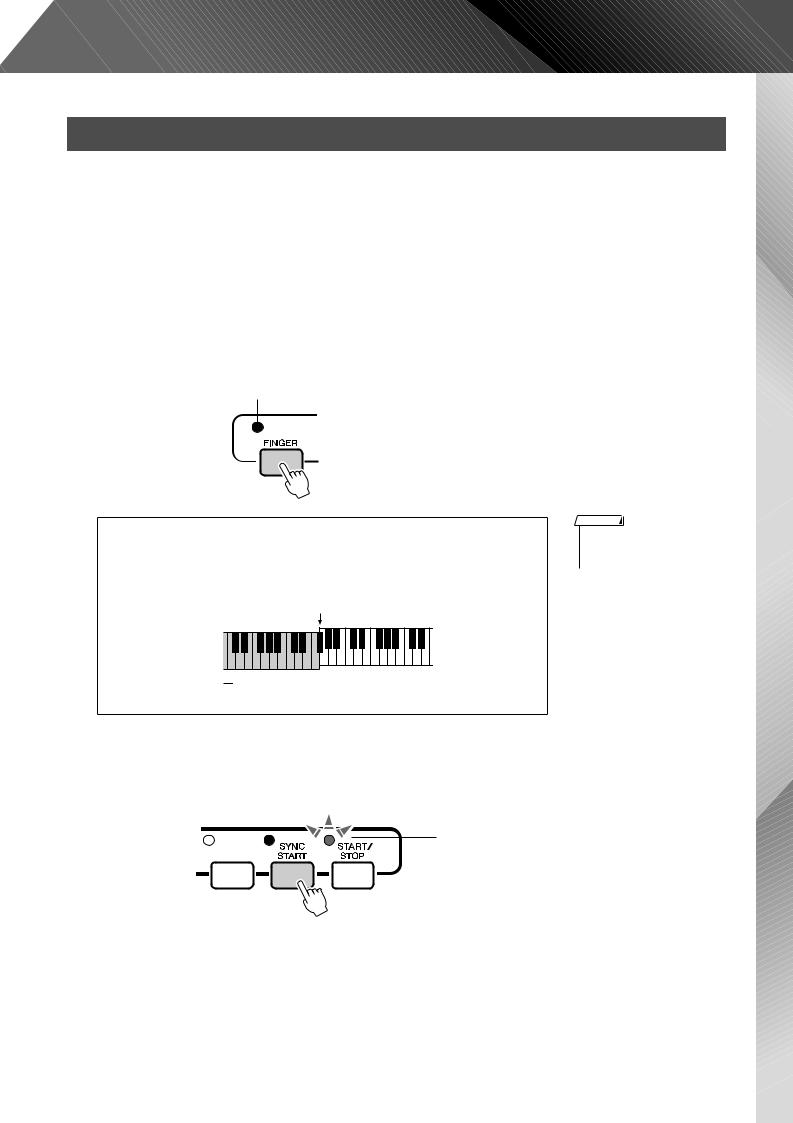
Playing Patterns
Play Along with a Pattern
You learned how to select a Pattern rhythm on the preceding page.
Here we’ll see how to add bass and chord accompaniment to the basic rhythm to produce a full, rich accompaniment that you can play along with.
1 Select the pattern you want to play (page 22, steps 1–2).
Press the [EXIT] button to return to the MAIN display screen.
2 Turn FINGER on.
Press the [FINGER] button.
Press the button a second time to turn the FINGER mode off.
The indicator lights when FINGER is ON.
●When FINGER is on ...
The area of the keyboard to the left of the split point (54 : F sharp 2) becomes the “auto accompaniment range” and is used only for specifying the accompaniment chords.
Split point (54/F#2)
NOTE
•The keyboard split point can be changed as required, as described on page 52.
Auto-accompani- 
ment Range
3 Turn sync start on.
Press the [SYNC START] button to turn the Sync Start function on.
The indicator will flash when Sync Start is on.
The “standby” mode will be engaged when the Sync Start function is turned on.
When sync start is on, the bass and chord accompaniment included in a pattern will start playing as soon as you play a note to left of the keyboard split point. Press the button a second time to turn the sync start function off.
MM6/MM8 Owner’s Manual 23
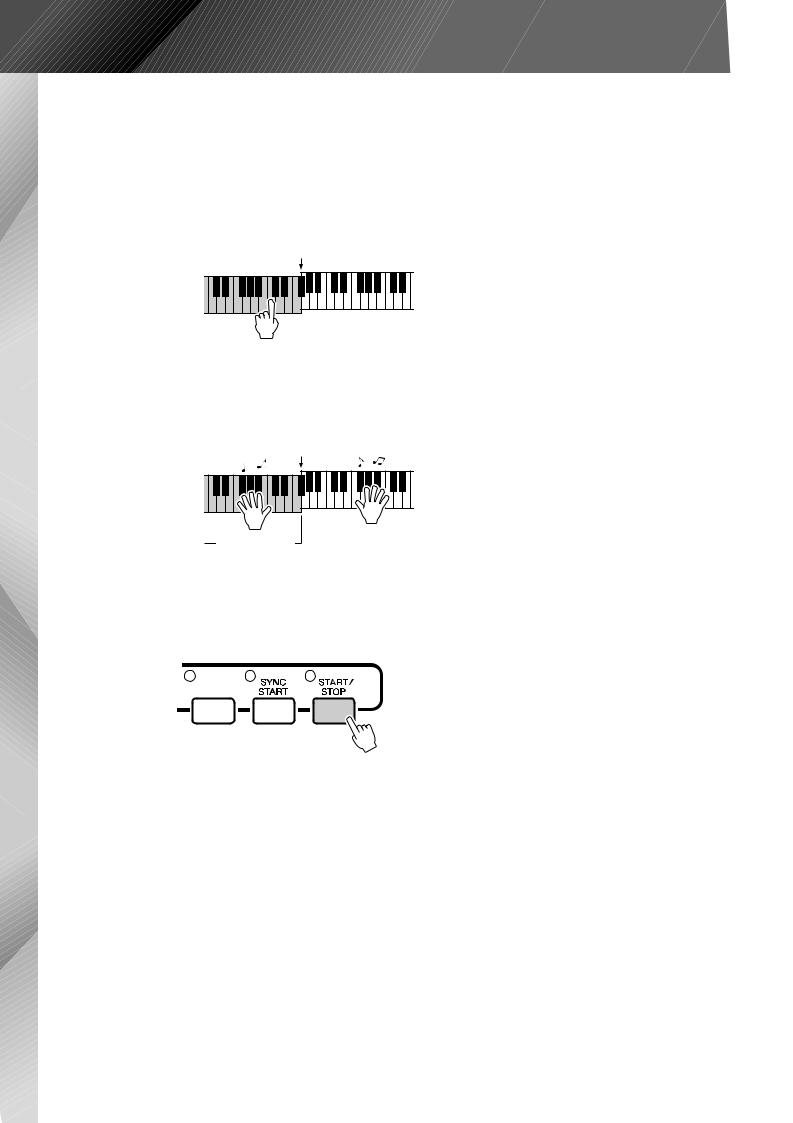
Playing Patterns
4 Play a left-hand chord to start the pattern.
If you don’t yet know how to play any chords, try playing anything you like on the keyboard. Refer to page 25 for information about playing chords.
The accompaniment will change according to the left-hand notes you play.
Split Point
5 Play a variety of left-hand chords while playing a melody with your right hand.
Split Point
Auto-accompani-
ment Range
6 Press the [START/STOP] button to stop pattern playback when you’re done.
You can switch pattern “sections” to add variety to the accompaniment. Refer to “Pattern Variations (Sections)” on page 51.
24 MM6/MM8 Owner’s Manual

Playing Patterns
Playing Auto-accompaniment Chords
There are two types of auto-accompaniment chords:
●Easy Chords
●Standard Chords
The instrument will automatically recognize the different chord types. This function is known as Multi Fingering.
The keyboard to the left of the split point (default: 54/F#2) becomes the “accompaniment range”. Play the accompaniment chords in this area of the keyboard.
Split point (default: 54/F#2)
|
|
|
|
|
|
|
|
|
|
|
|
|
|
|
|
|
|
|
|
|
|
|
|
|
|
|
|
|
|
|
|
|
|
|
|
|
|
|
Root Notes and the |
|
|
|
|
|
|
Db |
|
Eb |
|
|
F# |
|
G# |
|
Bb |
|
|
Db |
|
Eb |
|
|
F# |
|
|
|
|
|
|||||||||
Corresponding Keys |
|
|
|
C |
D |
E |
F |
G |
A |
B |
C |
D |
E |
F |
|
|
|
|
|
|
||||||||||||||||||
|
|
|
|
|
|
|
|
|
||||||||||||||||||||||||||||||
|
|
|
|
|
|
|
|
|
|
|
|
|
|
|
|
|
|
|
|
|
|
|
|
|
|
|
|
|
|
|
|
|
|
|
||||
|
|
|
|
|
|
|
|
|
|
|
|
Accompani- |
|
|
|
|
|
|
|
|
|
|
||||||||||||||||
|
|
|
|
|
|
|
|
|
|
|
|
|
|
|
|
|
||||||||||||||||||||||
|
|
|
|
|
|
|
|
|
|
|
|
ment Range |
|
|
|
|
|
|||||||||||||||||||||
■Easy Chords ● ● ● ● ● ● ● ● ● ● ● ● ● ● ● ●
This method lets you easily play chords in the accompaniment range of the keyboard using only one, two, or three fingers.
C
• To play a major chord
Press the root note of the chord.
Cm
• To play a minor chord
Press the root note together with the nearest black key to the left of it.
C7
• To play a seventh chord
Press the root note together with the nearest white key to the left of it.
Cm7
• To play a minor seventh chord
Press the root note together with the nearest white and black keys to the left of it (three keys altogether).
■Standard Chords ● ● ● ● ● ● ● ● ● ● ● ● ●
This method lets you produce accompaniment by playing chords using normal fingerings in the accompaniment range of the keyboard.
Standard Chord Fingerings [Examples for “C” chords]
C |
|
|
Cadd9 |
|
|
C6 |
(9) |
|
|
|
|
||||||||||||||||||||||
|
|
|
|
|
|
C6 |
|||||||||||||||||||||||||||
|
|
|
|
|
|
|
|
|
|
|
|
|
|
|
|
|
|
|
|
|
|
|
|
|
|
|
|
|
|
|
|
|
|
|
|
|
|
|
|
|
|
|
|
|
|
|
|
|
|
|
|
|
) |
|
|
|
|
|
|
|
|
|
|
) |
|
|
|
|
|
|
|
|
|
|
|
|
|
|
|
|
|
|
|
|
|
|
|
( |
|
|
|
|
|
|
|
|
|
|
( |
|
|
CM7 |
(9) |
|
|
|
|
|
(#11) |
|
|
|
|
|
|
|
(b5) |
||||||||||||||||||
|
|
CM7 |
|
|
CM7 |
|
|
C |
|||||||||||||||||||||||||
|
|
|
|
|
|
|
|
|
|
|
|
|
|
|
|
|
|
|
|
|
|
|
|
|
|
|
|
|
|
|
|
|
|
|
|
|
) |
|
|
|
|
|
|
|
) |
|
|
|
|
|
) |
|
|
|
|
|
|
|
|
|
|
|
|
|
|
|
|
|
|
|
( |
|
|
|
|
|
|
|
( |
|
|
|
|
|
( |
|
|
|
|
|
|
|
|
|
|
|
|
|
|
|
|
|
(b5) |
|
|
Csus4 |
|
|
Caug |
|
|
CM7aug |
|||||||||||||||||||||||
CM7 |
|
|
|
|
|
|
|||||||||||||||||||||||||||
|
|
|
|
|
|
|
|
|
|
|
|
|
|
|
|
|
|
|
|
|
|
|
|
|
|
|
|
|
|
|
|
|
|
|
|
|
|
|
|
|
|
|
|
|
|
|
|
|
|
|
|
|
|
|
|
|
|
|
|
|
|
|
) |
|
|
|
|
|
|
|
|
|
|
|
|
|
|
|
|
|
|
|
|
|
|
|
|
|
|
|
|
|
|
|
|
|
|
( |
|
|
|
Cm |
|
|
Cm add9 |
|
|
Cm6 |
|
|
Cm7 |
||||||||||||||||||||||||
|
|
|
|
|
|
|
|
|
|
|
|
|
|
|
|
|
|
|
|
|
|
|
|
|
|
|
|
|
|
|
|
|
|
|
|
|
|
|
|
|
|
|
|
|
|
|
|
|
|
|
|
|
|
|
|
|
|
|
|
|
|
|
|
) |
|
|
|
|
|
|
|
|
|
|
|
|
|
|
|
|
|
|
|
|
|
|
|
|
|
|
|
|
|
|
|
|
|
|
( |
|
|
(9) |
|
|
|
|
(11) |
|
|
|
|
|
|
CmM7 |
(9) |
|
|
|
|||||||||||||||||
Cm7 |
|
|
Cm7 |
|
|
|
|
CmM7 |
|||||||||||||||||||||||||
) |
( |
) |
) |
) |
) |
( |
( |
( |
( |
|
(b5) |
|
|
|
(b5) |
|
|
|
Cdim |
|
|
|
|
Cdim7 |
|||||||||||||||||||
Cm7 |
|
CmM7 |
|
|
|
|
|
|
|
||||||||||||||||||||||||
|
|
|
|
|
|
|
|
|
|
|
|
|
|
|
|
|
|
|
|
|
|
|
|
|
|
|
|
|
|
|
|
|
|
|
|
|
|
|
|
|
|
|
|
|
|
|
|
|
|
|
|
|
|
|
|
|
|
|
|
|
|
|
|
|
|
|
|
C7 |
|
|
(b9) |
|
|
|
|
(b13) |
(9) |
|
|
|
|
|
|
||||||||||||||||||
|
C7 |
|
|
|
C7 |
|
|
|
|
C7 |
|||||||||||||||||||||||
|
|
|
|
|
|
|
|
|
|
|
|
|
|
|
|
|
|
|
|
|
|
|
|
|
|
|
|
|
|
|
|
|
|
|
|
|
|
) |
|
|
|
|
|
|
|
) |
|
|
|
|
|
|
|
|
|
|
|
|
|
|
|
|
|
) |
|
|
|
|
|
|
|
( |
|
|
|
|
|
|
|
( |
|
|
|
|
|
|
|
|
|
|
|
|
|
|
|
|
|
( |
|
|
|
|
|
|
|
|
|
|
|
|
|
|
|
|
|
|
|
|
|
|
|
|
|
|
|
|
|
|
|
|
|
|
|
|
|
(#11) |
|
|
|
|
(13) |
|
|
|
(#9) |
|
|
|
|
|
|
(b5) |
|||||||||||||||||
C7 |
C7 |
|
|
|
C7 |
|
|
|
|
C7 |
|||||||||||||||||||||||
|
|
|
|
|
|
|
|
|
|
|
|
|
|
|
|
|
|
|
|
|
|
|
|
|
|
|
|
|
|
|
|
|
|
|
) |
|
|
|
|
|
|
|
|
|
|
) |
|
|
|
|
|
|
|
|
|
) |
|
|
|
|
|
|
|
|
|
|
|
|
( |
|
|
|
|
|
|
|
|
|
|
( |
|
|
|
|
|
|
|
|
|
( |
|
|
|
|
|
|
|
|
|
|
|
C7aug |
C7sus4 |
Csus2 |
|
|
) |
|
|
( |
Notes enclosed in parentheses  are optional; the chords will be recognized without them.
are optional; the chords will be recognized without them.
● Multi Fingering and Full Keyboard
These let you select the accompaniment section of the keyboard for chord playing.
When changing settings refer to “Specify Chords Over the Entire Keyboard Range” on page 56, and “Chord Fingering” on page 65.
Multi Fingering: As explained above, the keys to the left of the split point (default: 54, F#2) become the accompaniment range. Playing Auto-accompaniment Chords. There are two ways of playing auto-accompaniment chords: Easy Chords and Standard Chords. The default setting (factory setting) is “Multi Fingering.”
Full Keyboard: This let you play the accompaniment chords freely from anywhere on the keyboard.
MM6/MM8 Owner’s Manual 25
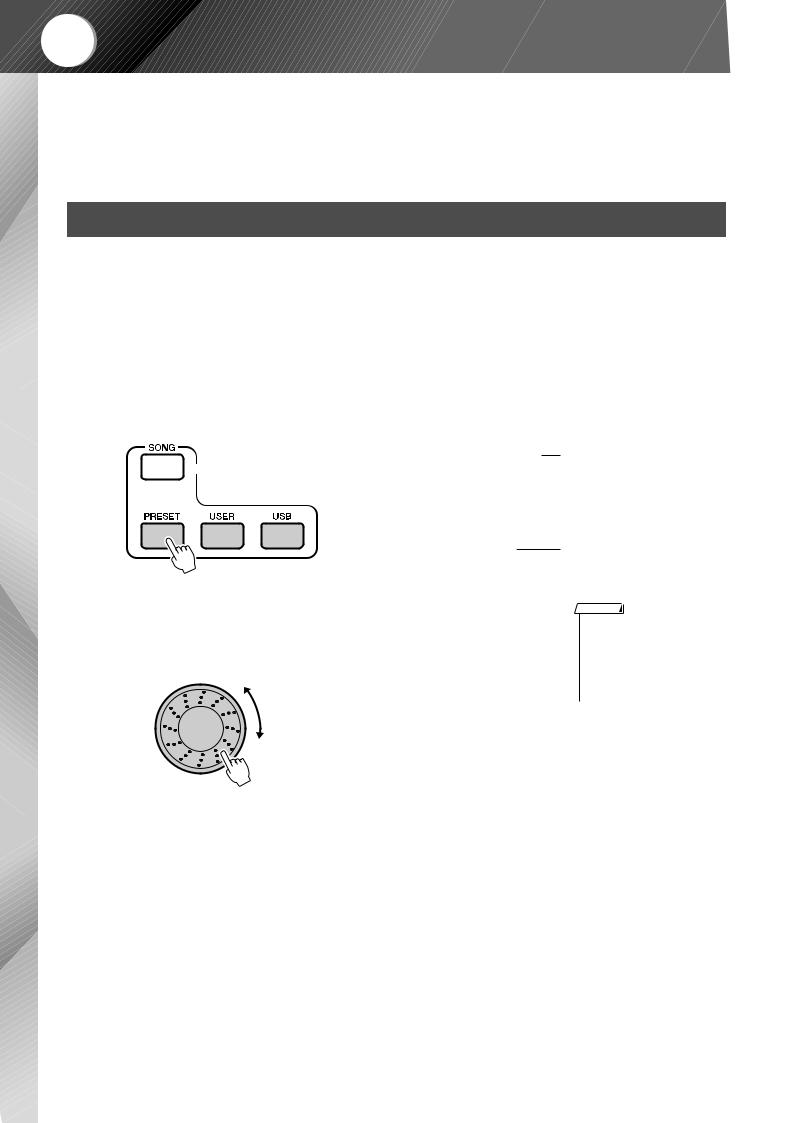
QuickGuide Using Songs
With this instrument the term “song” refers the data that makes up a piece of music.
In this section we’ll learn how to select and play songs.
Selecting and Listening to a Song
1 Select and press the SONG category button that corresponds to the type of song you want to listen to.
[PRESET] : Accesses the three internal preset songs.
[USER] |
: Accesses songs you have recorded yourself and songs |
|
loaded from computer. |
[USB] |
: Accesses songs stored on a USB storage device connected |
|
to the DEVICE terminal. |
The song selection display will appear.
The currently selected song number and name will be highlighted.
SONG SELECT
Display
Currently
Selected Song
2 Select a song you want to play.
Use the dial to select the Song you want to listen to.
The available songs will be selected and displayed in sequence.
NOTE
•User songs (songs you’ve recorded yourself) and songs on USB storage devices can also be played. The procedure for playing these types of songs is exactly the same as for playing the internal songs.
PRESET |
Internal songs (three songs) |
|
|
|
|
USER |
User songs (songs you have recorded yourself; page 29) |
|
|
|
|
USB |
Songs stored on a USB storage device connected to the instrument |
|
(page 67) |
||
|
||
|
|
26 MM6/MM8 Owner’s Manual

Using Songs
3 Listen to the song.
Press the [START/STOP] button to begin playback of the selected song. You can stop playback at any time by pressing the [START/STOP] button again.
Song start
Song Fast Forward, Fast Reverse, and Pause
These are just like the transport controls on a CD player, letting you fast forward [f], reverse [r] and pause [ 
 ] playback of the song.
] playback of the song.
|
|
|
|
|
|
|
|
|
|
|
|
|
|
|
|
|
[r] Fast Reverse |
[f] Fast Forward |
|
|
|
|
|
|
|
|
|
|
|
||||
|
|
|
|
|
|
|
|
|
|
|
||||||
|
|
|
[ |
|
|
|
] Pause |
|||||||||
|
|
|
|
|
||||||||||||
Press the fast reverse |
Press the fast forward |
|
|
|
Press the pause |
|||||||||||
button to rapidly |
button to rapidly skip |
|
|
|
button to pause |
|||||||||||
return to an earlier |
ahead to a later point |
|
|
|
playback. |
|||||||||||
point in the song. |
in the song. |
|
|
|
|
|
|
|
|
|
|
|
||||
MM6/MM8 Owner’s Manual 27
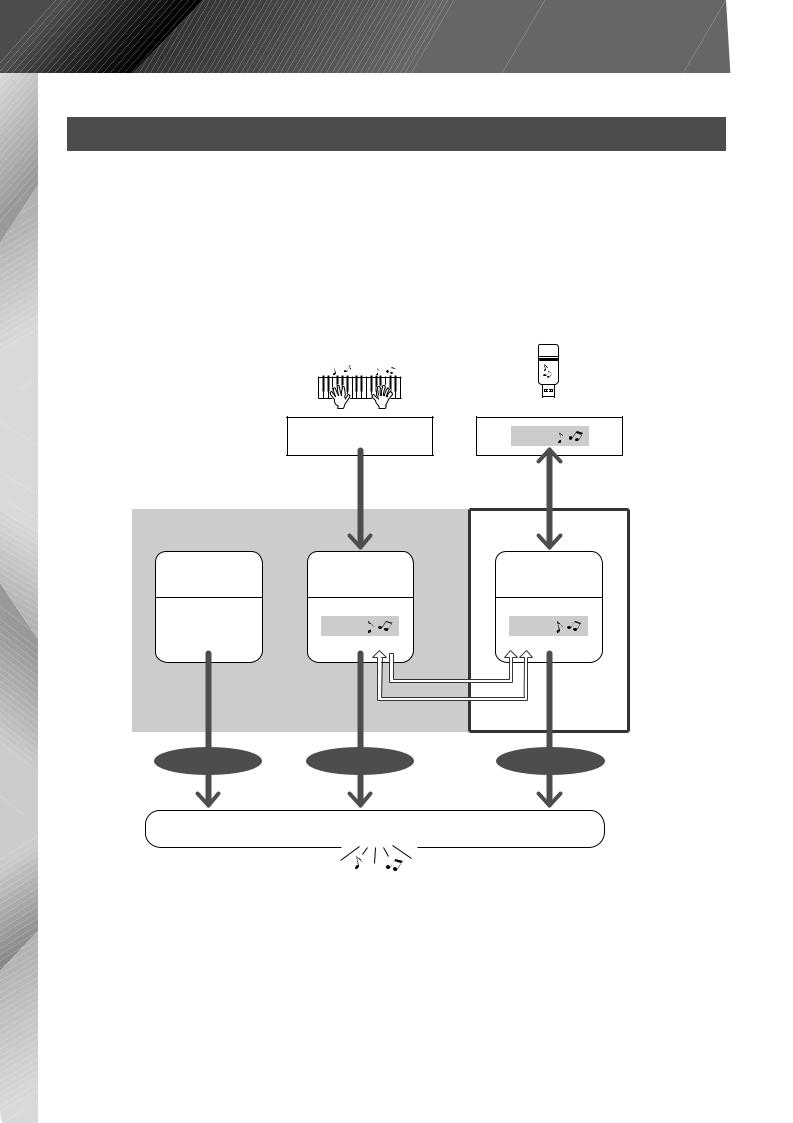
Using Songs
Types of Songs
The following three types songs can be used by this instrument.
● Preset Songs (the three songs built into the instrument) .......................................... |
Song numbers 001–003. |
● User Songs (recordings of your own performances) ................................................. |
Song numbers 001–005. |
● USB Songs (songs data in USB storage device)....................................................... |
Song numbers 001– |
The chart below shows the basic flow for using the preset songs, user songs, and USB songs from storage to playback.
Song Storage location
Preset Songs
(001–003)
The three songs built into the instrument.
Your Own Performance
Record
(page 29)
User Songs
(001–005)
Songs
USB Storage Device
Songs
Connect USB TO
DEVICE terminal and
Save/Load (page 75)
USB Songs
(001–)
Songs
SMF conversion
Save/Load as User Files
PRESET |
USER |
USB |
Play
28 MM6/MM8 Owner’s Manual
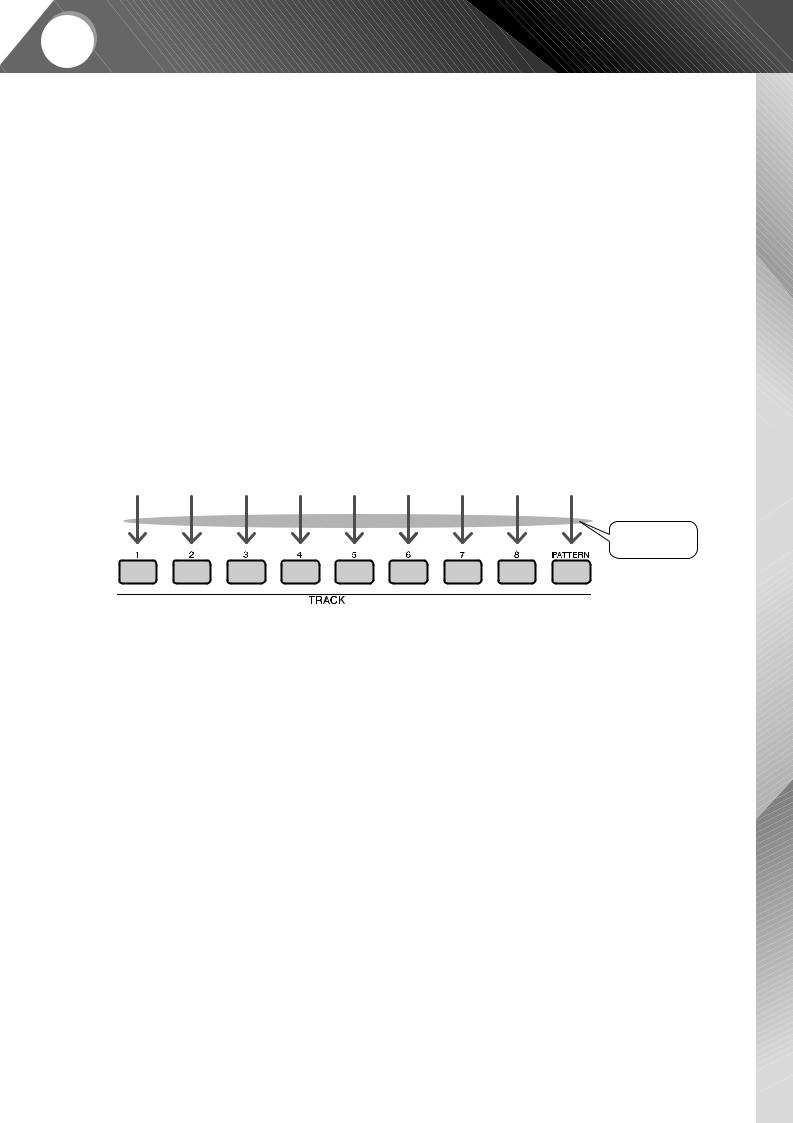
QuickGuide Recording Your Own Performance
You can record up to five of your own performances and save them as user songs 001 through 005. These Songs can be played in the same manner as the preset Songs.
Once your performances have been saved as user Songs, they can be converted to SMF (Standard MIDI File) format files and saved to USB storage device (page 70).
■ Recordable data
Eight tracks of keyboard performance and one pattern track (chord performance) can be recorded.
Each track can be recorded individually.
● |
Tracks [1]–[8] ........................................ |
Record keyboard performance (main voice only). |
● |
[PATTERN] Track ................................... |
Records pattern rhythm and chord parts. |
■ Track Mute
This instrument allows you to choose whether recorded tracks will play back while you are recording or playing back other tracks (page 58).
Melody or Other Keyboard Parts |
|
Chord |
|
Parts |
|
|
|
|
|
|
|
Specify Track(s)
and Record
Track |
|
Track |
|
Track |
|
Track |
|
Track |
|
Track |
|
Track |
|
Track |
|
Pattern |
1 |
|
2 |
|
3 |
|
4 |
|
5 |
|
6 |
|
7 |
|
8 |
|
Track |
MM6/MM8 Owner’s Manual 29
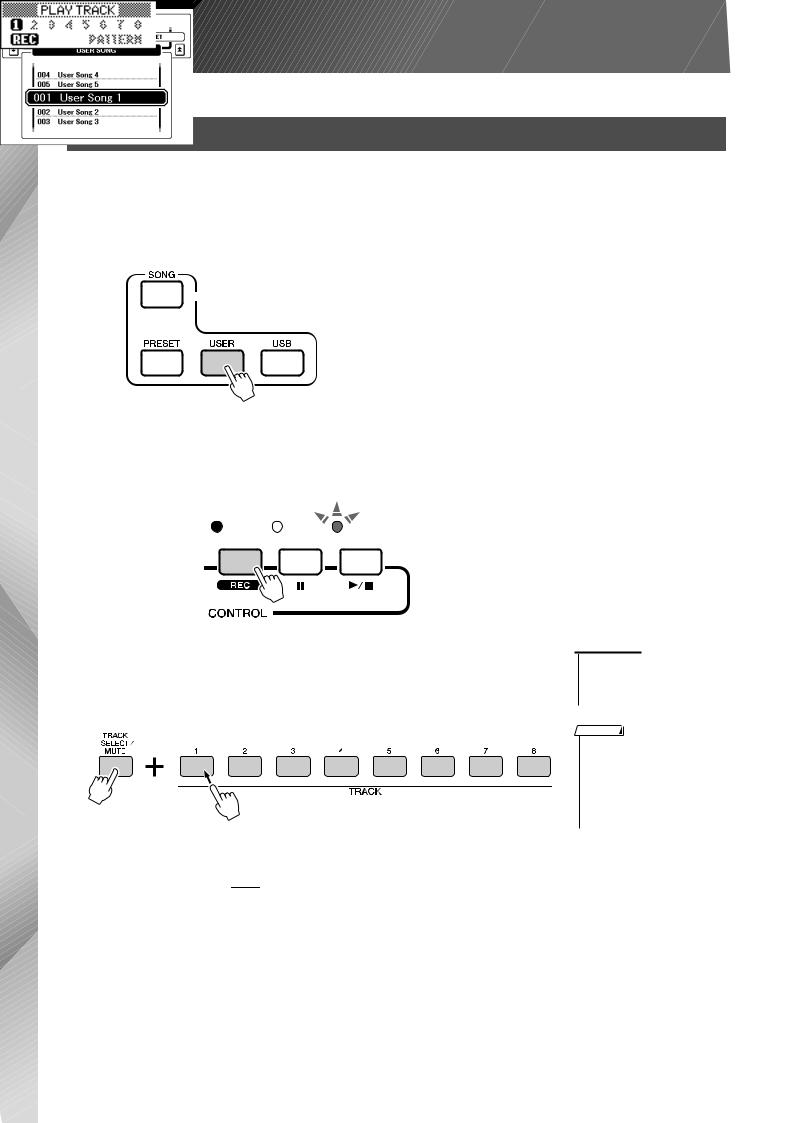
Recording Your Own Performance
Recording Procedure
Begin recording after selecting a user song number, and the track and part you want to record.
1 From the MAIN display press the [USER] button, then use the dial to select the user song number (001–005) you want to record.
2 Press the [REC] button.
The [REC] button will light.
3 Select the recording track.
Press the TRACK button ([1] to [8]) you want to record to while holding the [TRACK SELECT/MUTE] button.
The selected track will flash in the display.
Press and Hold
 CAUTION
CAUTION
•If you record to a track that contains previously-recorded data the previous data will be overwritten and lost.
NOTE
•The FINGER mode will be automatically turned on when you select the [PATTERN] track for recording.
•The FINGER mode cannot be turned on or off once you have started recording.
Track 1 will be highlighted.
30 MM6/MM8 Owner’s Manual
